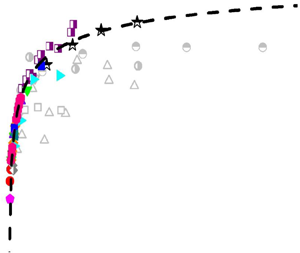Crossref Citations
This article has been cited by the following publications. This list is generated based on data provided by
Crossref.
Yu, Ming
and
Xu, Chun-Xiao
2021.
Compressibility effects on hypersonic turbulent channel flow with cold walls.
Physics of Fluids,
Vol. 33,
Issue. 7,
Chernyshenko, Sergei
2021.
Extension of QSQH theory of scale interaction in near-wall turbulence to all velocity components.
Journal of Fluid Mechanics,
Vol. 916,
Issue. ,
Birnir, Björn
Angheluta, Luiza
Kaminsky, John
and
Chen, Xi
2021.
Spectral link of the generalized Townsend-Perry constants in turbulent boundary layers.
Physical Review Research,
Vol. 3,
Issue. 4,
Wang, Chengyue
Gao, Qi
Wang, Biao
Pan, Chong
and
Wang, Jinjun
2021.
Vortex-to-velocity reconstruction for wall-bounded turbulence via the field-based linear stochastic estimation.
Journal of Fluid Mechanics,
Vol. 922,
Issue. ,
Smits, Alexander J.
Hultmark, Marcus
Lee, Myoungkyu
Pirozzoli, Sergio
and
Wu, Xiaohua
2021.
Reynolds stress scaling in the near-wall region of wall-bounded flows.
Journal of Fluid Mechanics,
Vol. 926,
Issue. ,
Xie, Jin-Han
de Silva, Charitha
Baidya, Rio
Yang, Xiang IA
and
Hu, Ruifeng
2021.
Third-order structure function in the logarithmic layer of boundary-layer turbulence.
Physical Review Fluids,
Vol. 6,
Issue. 7,
Yue, Peng
Xiao, Jingping
Xu, Ke
Li, Ming
Jiang, Feng
Lu, Yiyu
and
Peng, Dewei
2021.
Mathematical model and analysis method for flowfield separation and transition.
Physics of Fluids,
Vol. 33,
Issue. 4,
Basse, Nils T.
2021.
Scaling of global properties of fluctuating streamwise velocities in pipe flow: Impact of the viscous term.
Physics of Fluids,
Vol. 33,
Issue. 12,
Gao, Qingchun
Wang, Zhiming
Zeng, Quanshu
and
Chen, Shengnan Nancy
2021.
A Unified Model of Oil/Water Two-Phase Flow through the Complex Pipeline.
Geofluids,
Vol. 2021,
Issue. ,
p.
1.
Xie, Jiabin
He, Jianchao
Bao, Yun
and
Chen, Xi
2021.
A Low-Communication-Overhead Parallel DNS Method for the 3D Incompressible Wall Turbulence.
International Journal of Computational Fluid Dynamics,
Vol. 35,
Issue. 6,
p.
413.
Pirozzoli, Sergio
Romero, Joshua
Fatica, Massimiliano
Verzicco, Roberto
and
Orlandi, Paolo
2021.
One-point statistics for turbulent pipe flow up to .
Journal of Fluid Mechanics,
Vol. 926,
Issue. ,
Li, Xuebo
Wang, Guohua
and
Zheng, Xiaojing
2021.
Logarithmic energy profile of the streamwise velocity for wall-attached eddies along the spanwise direction in turbulent boundary layer.
Physics of Fluids,
Vol. 33,
Issue. 10,
Qiu, Yilong
Chen, Huiyu
Li, Wangxu
Wu, Feng
and
Li, Zhenggui
2021.
Optimization of the Tracer Particle Addition Method for PIV Flowmeters.
Processes,
Vol. 9,
Issue. 9,
p.
1614.
Basse, Nils T.
2021.
Scaling of global properties of fluctuating and mean streamwise velocities in pipe flow: Characterization of a high Reynolds number transition region.
Physics of Fluids,
Vol. 33,
Issue. 6,
Spalart, Philippe R.
and
Abe, Hiroyuki
2021.
Empirical scaling laws for wall-bounded turbulence deduced from direct numerical simulations.
Physical Review Fluids,
Vol. 6,
Issue. 4,
Wang, Hai-Ning
Huang, Wei-Xi
and
Xu, Chun-Xiao
2021.
Synthetic near-wall small-scale turbulence and its application in wall-modeled large-eddy simulation.
Physics of Fluids,
Vol. 33,
Issue. 9,
Yang, Xiang I. A.
Hong, Jiarong
Lee, Myoungkyu
and
Huang, Xinyi L. D.
2021.
Grid resolution requirement for resolving rare and high intensity wall-shear stress events in direct numerical simulations.
Physical Review Fluids,
Vol. 6,
Issue. 5,
Ma, Guo-Zhen
Xu, Chun-Xiao
Sung, Hyung Jin
and
Huang, Wei-Xi
2022.
Scaling of rough-wall turbulence in a transitionally rough regime.
Physics of Fluids,
Vol. 34,
Issue. 3,
Monkewitz, Peter A.
2022.
Asymptotics of streamwise Reynolds stress in wall turbulence.
Journal of Fluid Mechanics,
Vol. 931,
Issue. ,
Smits, Alexander J.
2022.
Batchelor Prize Lecture: Measurements in wall-bounded turbulence.
Journal of Fluid Mechanics,
Vol. 940,
Issue. ,

 $u^{\prime }$, is thought to be among the few exceptions. In particular, the near-wall mean-square peak,
$u^{\prime }$, is thought to be among the few exceptions. In particular, the near-wall mean-square peak,  $\overline {u'u'}^+_p$ – where the superscript
$\overline {u'u'}^+_p$ – where the superscript  $+$ indicates normalization by the friction velocity
$+$ indicates normalization by the friction velocity  $u_\tau$, the subscript
$u_\tau$, the subscript  $p$ indicates the peak value and the overbar indicates time averaging – is known to increase with increasing Reynolds number. The existing explanations suggest a logarithmic growth with respect to
$p$ indicates the peak value and the overbar indicates time averaging – is known to increase with increasing Reynolds number. The existing explanations suggest a logarithmic growth with respect to  $Re$, where
$Re$, where  $Re$ is the Reynolds number based on
$Re$ is the Reynolds number based on  $u_\tau$ and the thickness of the wall flow. We show that this boundless growth calls into question the veracity of wall-scaling and so cannot be sustained, and we establish an alternative formula for the peak magnitude that approaches a finite limit
$u_\tau$ and the thickness of the wall flow. We show that this boundless growth calls into question the veracity of wall-scaling and so cannot be sustained, and we establish an alternative formula for the peak magnitude that approaches a finite limit  $\overline {u'u'}^+_\infty$ owing to the natural constraint of boundedness on the dissipation rate at the wall. This new formula agrees well with the existing data and, in contrast to the logarithmic growth, supports the classical wall-scaling for turbulent intensity at asymptotically high Reynolds numbers.
$\overline {u'u'}^+_\infty$ owing to the natural constraint of boundedness on the dissipation rate at the wall. This new formula agrees well with the existing data and, in contrast to the logarithmic growth, supports the classical wall-scaling for turbulent intensity at asymptotically high Reynolds numbers.

